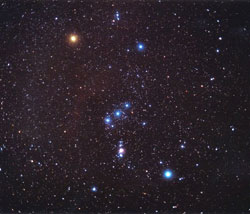|
|
Fellow stargazers! I remember when I was a young boy, my grandmother used to show me one of the most brilliant constellations in the sky - Orion the Hunter (known as Tin-Tare in Nepali). In March, it is right overhead just after sunset. If you have children or grandchildren, there is no greater gift you can give them than to pass on the love of the starry sky. Take the little ones out to look for Night Lights and show them this great constellation. Around Orion, you can see the brightest stars of the sky - the stars of the so-called 'Winter Hexagon'. To begin learning about our universe, all you have to do is look up at the night sky. After all, that's how astronomy began!
During March, you can also enjoy another brilliant constellation in the northern sky-Saptarshi (The Great Bear). One of the basic skills in stargazing is to locate the North Star (Polaris) with the help of the pointers of Saptarshi. If you want to, you can easily download finder charts for the North Star from the internet.
Planet observers can enjoy Mercury in the predawn sky as it reaches its greatest western elongation on 3 March. It will be in a good position for viewing about an hour before sunrise. Afterwards, it will change direction and start to head towards the east.
Venus is the bright body near Mercury and on the morning of 5 March the crescent Moon passes very close by both the planets. This promises to be a beautiful sight, as the thin sliver of moon will pass in front of the two planets. Throughout the rest of March, Venus and Mercury race towards the Sun, with Mercury overtaking Venus in the last week of the month.
Mars begins March on the eastern edge of Taurus but over the month it moves eastwards and into Gemini, becoming dimmer along the way. Jupiter is in Sagittarius and easy to spot because it is slightly brighter than Venus. Jupiter rises about three hours before the sun.
Are you ready to take a closer look at the real 'Lord of the Rings'? Then say hello to Saturn as it rises in the east at sunset, climbing the sky dome until it is overhead around midnight. Now is the time for observers and astro-photographers to enjoy Saturn the most!
Also, the Spring Equinox occurs on 20 March at 5.50 PM universal time. On that day the Sun will appear to move from south to north across the equator, and day and night will be exactly the same length. This event signals the start of spring in the Northern Hemisphere, which is how it gets its name.
As the nights are getting warmer, I suggest that you enjoy a stargazing session with your children. If you don't have electricity in the evening due to load-shedding, it's a great opportunity to come out and enjoy the treasures of the heavens, as anyhow the sky looks much clearer without city light pollution.
kedarbadu(at)gmail.com



